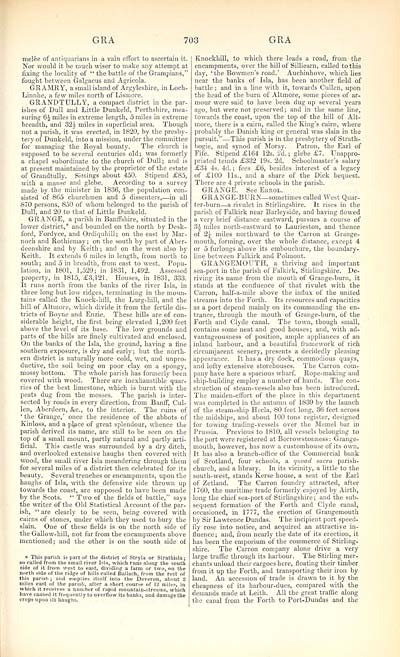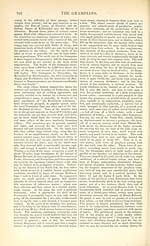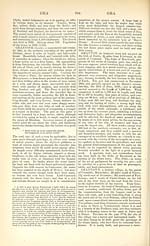Topographical, statistical, and historical gazetteer of Scotland > Volume 1
(803) Page 703
Download files
Complete book:
Individual page:
Thumbnail gallery: Grid view | List view

GRA
703
GRA
melee of antiquarians in a vain effort to ascertain it.
Nor would it be much wiser to make any attempt at
fixing the locality of " the battle of the Grampians,"
fought between Galgacus and Agricola.
GRAMRY, a small island of Argyleshire, in Loch-
Linnhe, a few miles north of Lismore.
GRANDTULLY, a compact district in the par-
ishes of Dull and Little Dunkeld, Perthshire, mea-
suring 6J miles in extreme length, 5 miles in extreme
breadth, and 32| miles in superficial area. Though
not a parish, it was erected, in 1820, by the presby-
tery of Dunkeld, into a mission, under the committee
for managing the Royal bounty. The church is
supposed to be several centuries old; was formerly
a chapel subordinate to the church of Dull; and is
at present maintained by the proprietor of the estate
of Grandtully. Sittings about 450. Stipend £85,
with a manse and glebe. According to a survey
made by the minister in 1836, the population con-
sisted of 865 churchmen and 5 dissenters, — in all
S70 persons, 850 of whom belonged to the parish of
Dull, and 20 to that of Little Dunkeld.
GRANGE, a parish in Banffshire, situated in the
lower district,* and bounded on the north by Desk-
ford, Fordyce, and Ordiquhill; on the east by Mar-
noch and Rothiemay ; on the south by part of Aber-
deenshire and by Keith ; and on the west also by
Keith. It extends 6 miles in length, from north to
south; and 5 in breadth, from east to west. Popu-
lation, in 1801, 1,529; in 1831, 1,492. Assessed
property, in 1815, £3,121. Houses, in 1831, 333.
It runs north from the banks of the river Isla, in
three long but low ridges, terminating in the moun-
tains called the Knock-hill, the Lurg-hill, and the
hill of Altmore, which divide it from the fertile dis-
tricts of Boyne and Enzie. These hills are of con-
siderable height, the first being elevated 1,200 feet
above the level of its base. The low grounds and
parts of the hills are finely cultivated and enclosed.
On the banks of the Isla, the ground, having a fine
southern exposure, is dry and early ; but the north-
ern district is naturally more cold, wet, and unpro-
ductive, the soil being on poor clay on a spongy,
mossy bottom. The whole parish has formerly been
covered with wood. There are inexhaustible quar-
ries of the best limestone, which is burnt with the
peats dug from the mosses. The parish is inter-
sected by roads in every direction, from Banff, Cul-
len, Aberdeen, &c, to the interior. The ruins of
'the Grange,' once the residence of the abbots of
Kinloss, and a place of great splendour, whence the
parish derived its name, are still to be seen on the
top of a small mount, partly natural and partly arti-
ficial. This castle was surrounded by a dry ditch,
and overlooked extensive haughs then covered with
wood, the small river Isla meandering through them
for several miles of a district then celebrated for its
beauty. Several trenches or encampments, upon the
haughs of Isla, with the defensive side thrown up
towards the coast, are supposed to have been made
by the Scots. " Two of the fields of battle," says
the writer of the Old Statistical Account of the par-
ish, "are clearly to be seen, being covered with
cairns of stones, under which they used to bury the
slain. One of these fields is on the north side of
the Gallow-hill, not far from the encampments above
mentioned; and the other is on the south side of
* This parish is part of the district of Stryla or Strathisla;
so called from the small river Isla, which runs along the south
6ide of it from west to east, dividing a farm or two, on the
north side of the ridge of hills called Ballach, from the rest of
this parish ; and empties itself into the Deveron, about 2
miles east of the parish, after a short course of 12 miles, in
which it receives a number of rapid mountain-streams, which
have caused it frequently to overflow its banks, and damage the
crops upon its haughs.
Knockhill, to which there leads a road, from the
encampments, over the hill of Silliearn, called to this
day, 'the Bowmen's road.' Auchinhove, which lies
near the banks of Isla, has been another field of
battle ; and in a line with it, towards Cullen, upon
the head of the burn of Altmore, some pieces of ar-
mour were said to have been dug up several years
ago, but were not preserved; and in the same line,
towards the coast, upon the top of the hill of Alt-
more, there is a cairn, called the King's cairn, where
probably the Danish king or general was slain in the
pursuit." — This parish is in the presbytery of Strath-
bogie, and synod of Moray. Patron, the Earl of
Fife. Stipend £164 12s. 2d.; glebe £7. Unappro-
priated teinds £332 19s. 2d. Schoolmaster's salary
£34 4s. 4d. ; fees £6, besides interest of a legacy
of £100 lis., and a share of the Dick bequest.
There are 4 private schools in the parish.
GRANGE. See Erroi..
GRANGE-BURN— sometimes called West Quar-
ter-burn — a rivulet in Stirlingshire. It rises in the
parish of Falkirk near Barleyside, and having flowed
a very brief distance eastward, pursues a course of
3J miles north-eastward to Laurieston, and thence
of 2j- miles northward to the Carron at Grange-
mouth, forming, over the whole distance, except 4
or 5 furlongs above its embouchure, the boundary-
line between Falkirk and Polmont.
GRANGEMOUTH, a thriving and important
sea-port in the parish of Falkirk, Stirlingshire. De-
riving its name from the mouth of Grange-burn, it
stands at the confluence of that rivulet with the
Carron, half-a-mile above the influx of the united
streams into the Forth. Its resources and capacities
as a port depend mainly on its commanding the en-
trance, through the mouth of Grange-burn, of the
Forth and Clyde canal. The town, though small,
contains some neat and good houses; and, with ad-
vantageousness of position, ample appliances of an
inland harbour, and a beautiful framework of rich
circumjacent scenery, presents a decidedly pleasing
appearance. It has a dry dock, commodious quays,
and lofty extensive storehouses. The Carron com-
pany have here a spacious wharf. Rope-making and
ship-building employ a number of hands. The con-
struction of steam- vessels also has been introduced.
The maiden-effort of the place in this department
was completed in the autumn of 1839 by the launch
of the steam-ship Hecla, 80 feet long, 36 feet across
the midships, and about 100 tons register, designed
for towing trading-vessels over the Memel bar in
Prussia. Previous to 1810, all vessels belonging to
the port were registered at Borrowstonness: Grange-
mouth, however, has now a customhouse of its own.
It has also a branch-office of the Commercial bank
of Scotland, four schools, a quoad sacra parish-
church, and a library. In its vicinity, a little to the
south-west, stands Kerse house, a seat of the Earl
of Zetland. The Carron foundry attracted, after
1760, the maritime trade formerly enjoyed by Airth,
long the chief sea-port of Stirlingshire; and the sub-
sequent formation of the Forth and Clyde canal,
occasioned, in 1777, the erection of Grangemouth
by Sir Lawrence Dundas. The incipient port speed-
ily rose into notice, and acquired an attractive in-
fluence ; and, from nearly the date of its erection, it
has been the emporium of the commerce of Stirling-
shire. The Carron company alone drive a very
large traffic through its harbour. The Stirling mer-
chants unload their cargoes here, floating their timber
from it up the Forth, and transporting their iron by
land. An accession of trade is drawn to it by the
cheapness of its harbour-dues, compared with the
demands made at Leith. All the great traffic along
the canal from the Forth to Port-Dundas and the
703
GRA
melee of antiquarians in a vain effort to ascertain it.
Nor would it be much wiser to make any attempt at
fixing the locality of " the battle of the Grampians,"
fought between Galgacus and Agricola.
GRAMRY, a small island of Argyleshire, in Loch-
Linnhe, a few miles north of Lismore.
GRANDTULLY, a compact district in the par-
ishes of Dull and Little Dunkeld, Perthshire, mea-
suring 6J miles in extreme length, 5 miles in extreme
breadth, and 32| miles in superficial area. Though
not a parish, it was erected, in 1820, by the presby-
tery of Dunkeld, into a mission, under the committee
for managing the Royal bounty. The church is
supposed to be several centuries old; was formerly
a chapel subordinate to the church of Dull; and is
at present maintained by the proprietor of the estate
of Grandtully. Sittings about 450. Stipend £85,
with a manse and glebe. According to a survey
made by the minister in 1836, the population con-
sisted of 865 churchmen and 5 dissenters, — in all
S70 persons, 850 of whom belonged to the parish of
Dull, and 20 to that of Little Dunkeld.
GRANGE, a parish in Banffshire, situated in the
lower district,* and bounded on the north by Desk-
ford, Fordyce, and Ordiquhill; on the east by Mar-
noch and Rothiemay ; on the south by part of Aber-
deenshire and by Keith ; and on the west also by
Keith. It extends 6 miles in length, from north to
south; and 5 in breadth, from east to west. Popu-
lation, in 1801, 1,529; in 1831, 1,492. Assessed
property, in 1815, £3,121. Houses, in 1831, 333.
It runs north from the banks of the river Isla, in
three long but low ridges, terminating in the moun-
tains called the Knock-hill, the Lurg-hill, and the
hill of Altmore, which divide it from the fertile dis-
tricts of Boyne and Enzie. These hills are of con-
siderable height, the first being elevated 1,200 feet
above the level of its base. The low grounds and
parts of the hills are finely cultivated and enclosed.
On the banks of the Isla, the ground, having a fine
southern exposure, is dry and early ; but the north-
ern district is naturally more cold, wet, and unpro-
ductive, the soil being on poor clay on a spongy,
mossy bottom. The whole parish has formerly been
covered with wood. There are inexhaustible quar-
ries of the best limestone, which is burnt with the
peats dug from the mosses. The parish is inter-
sected by roads in every direction, from Banff, Cul-
len, Aberdeen, &c, to the interior. The ruins of
'the Grange,' once the residence of the abbots of
Kinloss, and a place of great splendour, whence the
parish derived its name, are still to be seen on the
top of a small mount, partly natural and partly arti-
ficial. This castle was surrounded by a dry ditch,
and overlooked extensive haughs then covered with
wood, the small river Isla meandering through them
for several miles of a district then celebrated for its
beauty. Several trenches or encampments, upon the
haughs of Isla, with the defensive side thrown up
towards the coast, are supposed to have been made
by the Scots. " Two of the fields of battle," says
the writer of the Old Statistical Account of the par-
ish, "are clearly to be seen, being covered with
cairns of stones, under which they used to bury the
slain. One of these fields is on the north side of
the Gallow-hill, not far from the encampments above
mentioned; and the other is on the south side of
* This parish is part of the district of Stryla or Strathisla;
so called from the small river Isla, which runs along the south
6ide of it from west to east, dividing a farm or two, on the
north side of the ridge of hills called Ballach, from the rest of
this parish ; and empties itself into the Deveron, about 2
miles east of the parish, after a short course of 12 miles, in
which it receives a number of rapid mountain-streams, which
have caused it frequently to overflow its banks, and damage the
crops upon its haughs.
Knockhill, to which there leads a road, from the
encampments, over the hill of Silliearn, called to this
day, 'the Bowmen's road.' Auchinhove, which lies
near the banks of Isla, has been another field of
battle ; and in a line with it, towards Cullen, upon
the head of the burn of Altmore, some pieces of ar-
mour were said to have been dug up several years
ago, but were not preserved; and in the same line,
towards the coast, upon the top of the hill of Alt-
more, there is a cairn, called the King's cairn, where
probably the Danish king or general was slain in the
pursuit." — This parish is in the presbytery of Strath-
bogie, and synod of Moray. Patron, the Earl of
Fife. Stipend £164 12s. 2d.; glebe £7. Unappro-
priated teinds £332 19s. 2d. Schoolmaster's salary
£34 4s. 4d. ; fees £6, besides interest of a legacy
of £100 lis., and a share of the Dick bequest.
There are 4 private schools in the parish.
GRANGE. See Erroi..
GRANGE-BURN— sometimes called West Quar-
ter-burn — a rivulet in Stirlingshire. It rises in the
parish of Falkirk near Barleyside, and having flowed
a very brief distance eastward, pursues a course of
3J miles north-eastward to Laurieston, and thence
of 2j- miles northward to the Carron at Grange-
mouth, forming, over the whole distance, except 4
or 5 furlongs above its embouchure, the boundary-
line between Falkirk and Polmont.
GRANGEMOUTH, a thriving and important
sea-port in the parish of Falkirk, Stirlingshire. De-
riving its name from the mouth of Grange-burn, it
stands at the confluence of that rivulet with the
Carron, half-a-mile above the influx of the united
streams into the Forth. Its resources and capacities
as a port depend mainly on its commanding the en-
trance, through the mouth of Grange-burn, of the
Forth and Clyde canal. The town, though small,
contains some neat and good houses; and, with ad-
vantageousness of position, ample appliances of an
inland harbour, and a beautiful framework of rich
circumjacent scenery, presents a decidedly pleasing
appearance. It has a dry dock, commodious quays,
and lofty extensive storehouses. The Carron com-
pany have here a spacious wharf. Rope-making and
ship-building employ a number of hands. The con-
struction of steam- vessels also has been introduced.
The maiden-effort of the place in this department
was completed in the autumn of 1839 by the launch
of the steam-ship Hecla, 80 feet long, 36 feet across
the midships, and about 100 tons register, designed
for towing trading-vessels over the Memel bar in
Prussia. Previous to 1810, all vessels belonging to
the port were registered at Borrowstonness: Grange-
mouth, however, has now a customhouse of its own.
It has also a branch-office of the Commercial bank
of Scotland, four schools, a quoad sacra parish-
church, and a library. In its vicinity, a little to the
south-west, stands Kerse house, a seat of the Earl
of Zetland. The Carron foundry attracted, after
1760, the maritime trade formerly enjoyed by Airth,
long the chief sea-port of Stirlingshire; and the sub-
sequent formation of the Forth and Clyde canal,
occasioned, in 1777, the erection of Grangemouth
by Sir Lawrence Dundas. The incipient port speed-
ily rose into notice, and acquired an attractive in-
fluence ; and, from nearly the date of its erection, it
has been the emporium of the commerce of Stirling-
shire. The Carron company alone drive a very
large traffic through its harbour. The Stirling mer-
chants unload their cargoes here, floating their timber
from it up the Forth, and transporting their iron by
land. An accession of trade is drawn to it by the
cheapness of its harbour-dues, compared with the
demands made at Leith. All the great traffic along
the canal from the Forth to Port-Dundas and the
Set display mode to: Large image | Transcription
Images and transcriptions on this page, including medium image downloads, may be used under the Creative Commons Attribution 4.0 International Licence unless otherwise stated. ![]()
| Gazetteers of Scotland, 1803-1901 > Topographical, statistical, and historical gazetteer of Scotland > Volume 1 > (803) Page 703 |
|---|
| Permanent URL | https://digital.nls.uk/97447182 |
|---|
| Description | Volume first. A-H. |
|---|---|
| Attribution and copyright: |
|

